Edition 6/October 2024 The Evolution of Vaccines: Global and African Perspectives in the Pharmaceutical Industry Dr Prosper Hiag FIP Vice-President One of the greatest contributions to public health has been the development of vaccines, which provide immunity to infectious diseases and save millions of lives every year. The development, manufacturing, and distribution of vaccinations have been greatly aided by the global pharmaceutical industry. The environment of the sector has clearly changed in the last few years, particularly with regard to Africa. With an emphasis on the function of the International Pharmaceutical Federation (FIP), this article examines the perspectives that are emerging in the pharmaceutical industries in Africa and around the world. Major companies in North America, Europe, and Asia have long held a dominant position in the global pharmaceutical sector. In the African continent, Northern Part of Africa (Morocco, Algeria, Tunisia), Sub-Saharan Africa (a part of South Africa) have improved in access to health insurance, well-organised health systems and well-established pharmaceutical industries; Recent patterns, however, point to a more inclusive and diverse environment. The COVID-19 pandemic accelerated the need for rapid vaccine development and distribution, highlighting the importance of global collaboration and the potential of emerging markets and the pivotal role of vaccines, particularly in preventing COVID-19 infections. One of the most notable changes in the global pharmaceutical industry is the rapid advancement in vaccine technology. mRNA vaccines, developed by companies like Pfizer-BioNTech and Moderna, have revolutionized vaccine development. The success of mRNA vaccines during the COVID-19 pandemic has spurred further research into their potential applications, including vaccines for other infectious diseases and cancer. The pandemic also underscored the need for global cooperation to ensure equitable access to vaccines. Initiatives like COVAX, co-led by Gavi, the Vaccine Alliance, the World Health Organization (WHO), and the Coalition for Epidemic Preparedness Innovations (CEPI), have aimed to provide fair access to COVID-19 vaccines for all countries, regardless of income. While challenges remain, such as supply chain issues, sub-standard medicines, medicines costs and vaccine hesitancy, these efforts have highlighted the importance of solidarity and shared responsibility in global health. Previously, rather than manufacturing vaccines, Africa was simply a beneficiary of them. …/ continued on page 3 The Golden Mortar 6/2024 1

1-4 The Evolution of Vaccines 10 FIP Industrial Pharmacy Section Medal Award 2024 5-6 Know What You Don’t Know 4 Professional Indemnity Insurance 9 National Pharmacy Museum Artefacts 10 The PSSA Book Department 13 PSSA SG Branch FIP Representatives 14 - 16 FIP Brief Report by PSSA SG Member 7-9 Holistic Healthcare: TCAM 12 SAACP Webpage 11 - 12 SAAHIP Pharmacy Month Outreach 16 SAAHIP FIP Representatives SAAPI FIP Representatives I want to extend my heartfelt thanks to each of you for your dedication and hard work in making our recent Symposium a resounding success. Your commitment to excellence and attention to detail truly made a difference! Thank you once again for your invaluable contributions. Tshif Rabali Chairman PSSA SG Branch More info on our next edition of The Golden Mortar... The Golden Mortar 6/2024 2
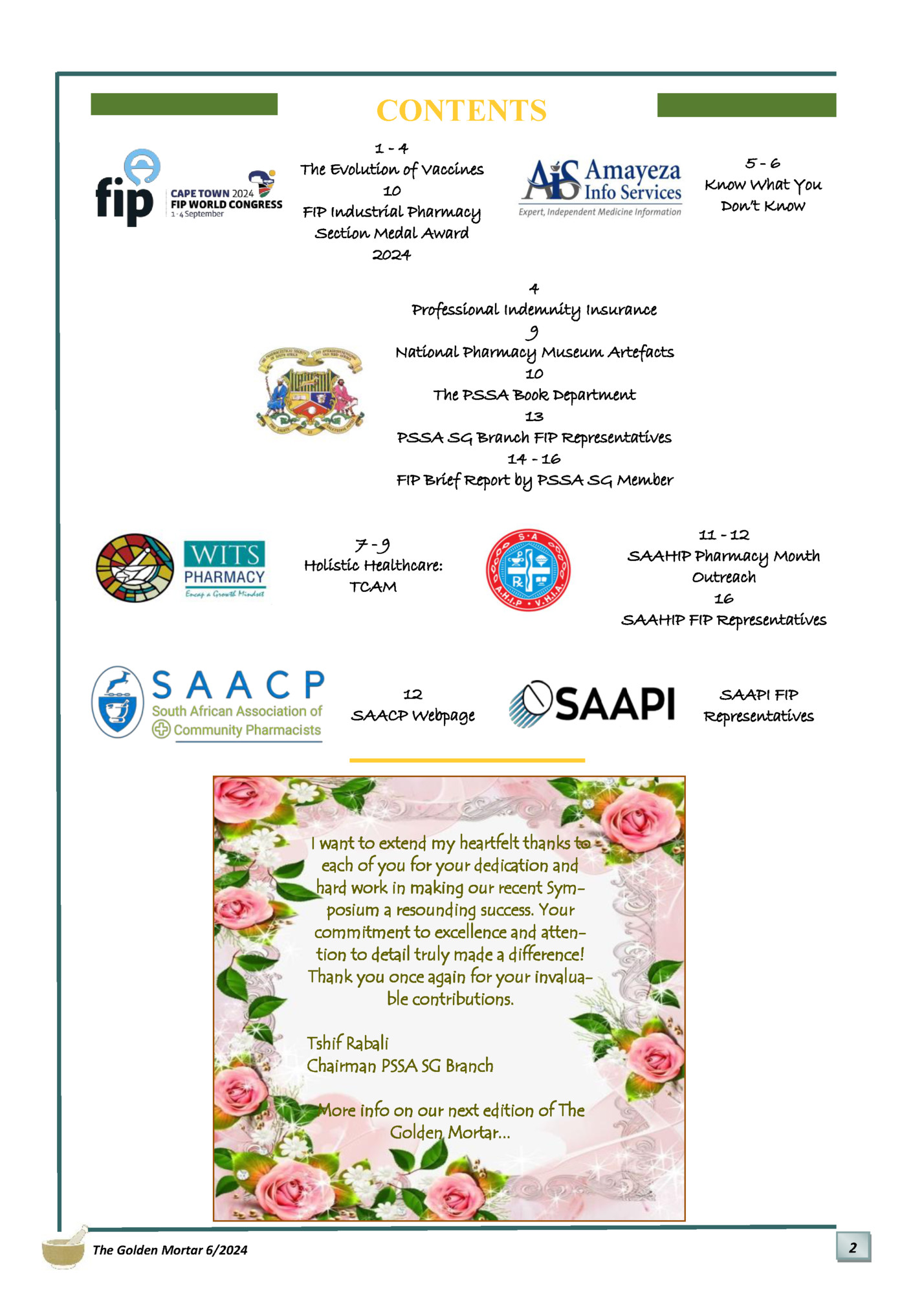
However, this dynamic is changing as African countries invest in developing their pharmaceutical industries. This shift is driven by the recognition that self-sufficiency in vaccine production is crucial for public health security and economic growth. Another initiative is the African Vaccine Manufacturing Accelerator (AVMA), a high-level event co-hosted in Paris by the Government of France, the African Union, and Gavi, the Vaccine Alliance, along with the support of Team Europe. This initiative will provide a finance mechanism established to make up to US$ 1.2 billion available over ten years commencing with AVMA’s launch in June 2024 to accelerate the expansion of commercially viable vaccine manufacturing in Africa. Several African nations have made significant strides in building the necessary infrastructure for vaccine production. South Africa, Algeria, Morocco, Egypt, and Senegal are emerging as key players in this space. For example, South Africa's Biovac Institute is collaborating with international partners to produce COVID19 vaccines locally. These efforts are part of a broader trend to reduce reliance on imports and strengthen the continent's ability to respond to health emergencies. Collaboration with global pharmaceutical companies and international organizations has been essential in developing Africa's vaccine production capacity. Technology transfer agreements, joint ventures, and partnerships have enabled African countries to acquire the expertise and technology needed to manufacture vaccines. The African Union and the Africa Centers for Disease Control and Prevention (Africa CDC) have been instrumental in facilitating these collaborations and advocating for increased investment in the continent's pharmaceutical sector. The International Pharmaceutical Federation (FIP) is a global organization representing pharmacists, pharmaceutical scientists, and pharmaceutical educators. FIP plays a crucial role in shaping the pharmaceutical industry's future by promoting best practices, supporting research and innovation, and advocating for policies that improve public health. The FIP Development Goals supporting vaccination program world white are: FIP has been active in promoting the importance of vaccines and supporting pharmacists' role in vaccination. Pharmacists are increasingly recognized as key players in the vaccine delivery chain, providing access to vaccines and educating the public about their benefits. FIP has developed guidelines and resources to support pharmacists in these roles, helping to improve vaccine coverage and combat misinformation. Some of the programs and activities are highlight below: • • Transforming Vaccination Globally, Regionally, nationally: Accelerating equity, access and sustainability through policy development and implementation. https:// transformingvaccination.fip.org/ FIP’s vaccine equity program centred around advancing vaccine equity and life-course immunization. https://equityrx.fip.org/vaccine-equity • The FIP vaccination reference guide. https://www.fip.org/file/5158 • The FIP Global Roadmap 2030: Sustainable advancement for pharmacy worldwide. https:// developmentgoals.fip.org/globalroadmap2030/ FIP collaborates with various international organizations, including the WHO, to advance global health initiatives. …/ continued on page 4 The Golden Mortar 6/2024 3
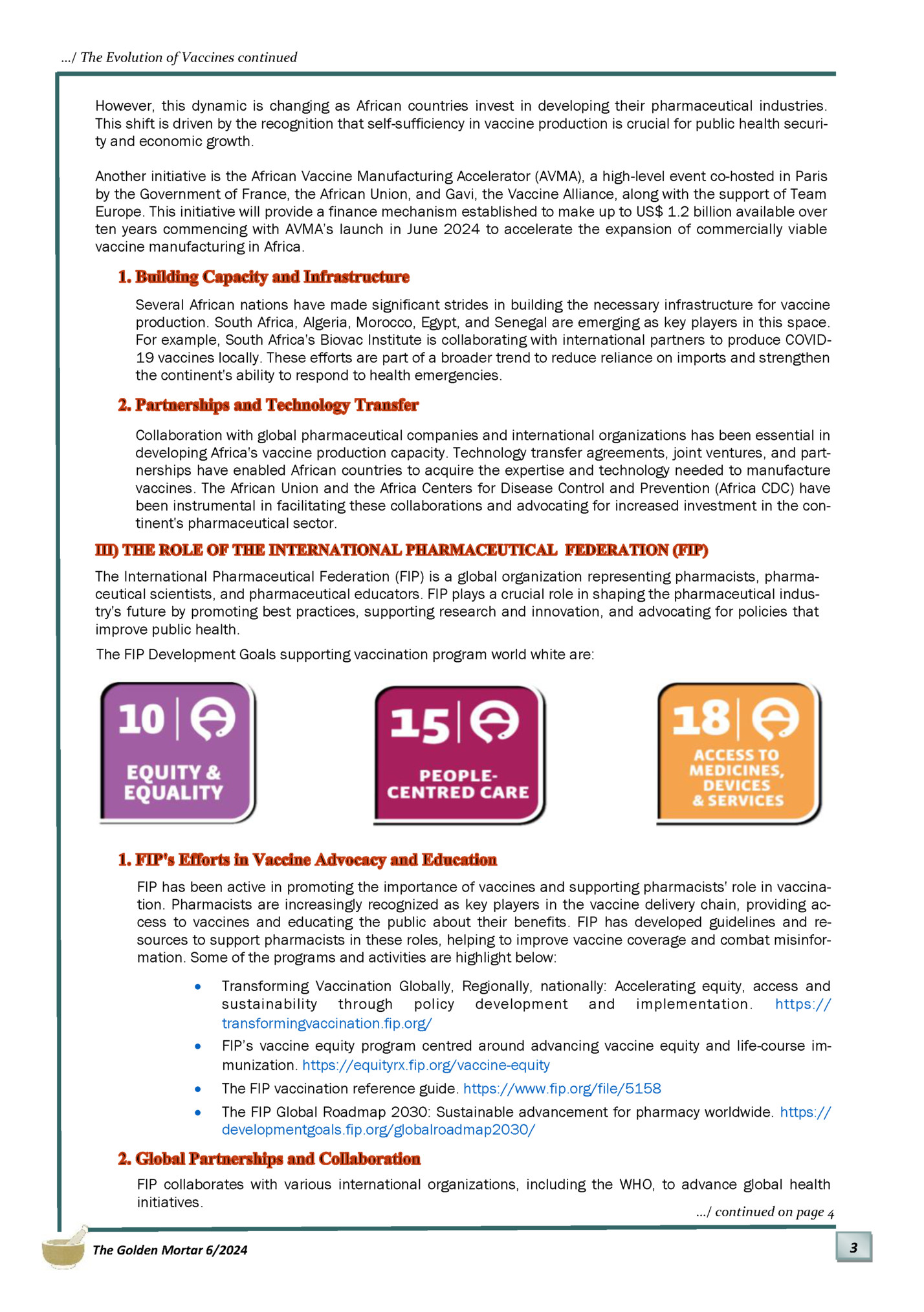
Through these partnerships, FIP advocates for policies that enhance vaccine access and equity. The organization also emphasizes the importance of research and innovation in developing new vaccines and improving existing ones. The global and African pharmaceutical industries are undergoing significant transformations, with new perspectives emerging on vaccine development, production, and distribution. The rapid advancement of vaccine technology, increased global collaboration, and the growing capacity of African countries to produce vaccines are reshaping the industry's landscape. The International Pharmaceutical Federation (FIP) continues to play a vital role in advocating for vaccines and supporting the pharmaceutical community in addressing public health challenges. As the world faces ongoing and emerging health threats, the importance of vaccines and the pharmaceutical industry's role in safeguarding global health cannot be overstated. The Golden Mortar 6/2024 4
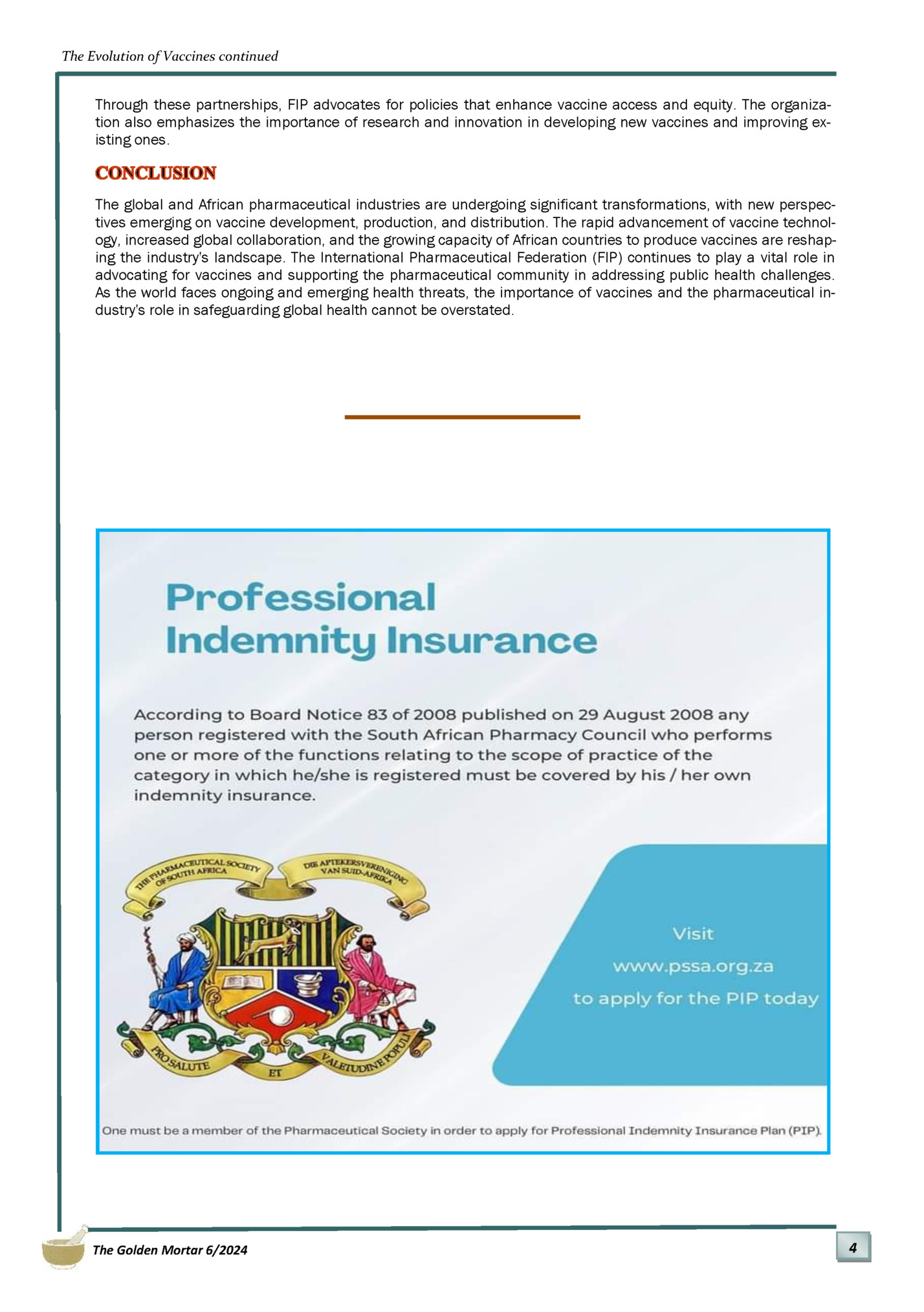
Lynda Steyn (BPharm) September is Pharmacy Month, and the theme this year is “Let’s talk about vaccines” Worldwide, the role of the pharmacist is expanding and shifting from its more traditional role towards a more patient-centred role. There is great opportunity in South Africa for pharmacists to up-skill and expand their scope of practice to include immunisation services, among many other services. However, we cannot confidently advocate for vaccines if we “don’t know what we don’t know.” Yes, let’s talk about vaccines, but before that let’s learn about vaccines. Vaccines are classified as medications, and, like any medication, have both benefits and risks associated with their use. As the custodians of medicines, we should be able to answer difficult vaccine-related questions, have a good understanding about how vaccines work, address myths, catch-up children who have defaulted on their vaccination schedule, and confidently advise teens, adults, pregnant women and high-risk groups on recommended vaccines. This article aims to highlight a few frequently asked questions in order to illustrate the complexity and depth of knowledge that is required to confidently advise about vaccines. What is the difference between the pneumococcal conjugate vaccine (Prevenar 13®, Synflorix, Cipla PCV10®) and the pneumococcal polysaccharide vaccine (Pneumovax 23®)? Why should we differentiate between them if they both protect against invasive pneumococcal disease? Children under the age of 2 years are unable to properly mount a good immune response without the aid of the T-cells (cellular response) in the immune system. Certain bacteria, such as Streptococcus pneumoniae are encapsulated, which enables them to evade the immune system. Similarly, a pure polysaccharide vaccine will not elicit a T-cell response and will therefore not be effective in children under 2 years of age. A conjugated vaccine is conjugated (joined) to an antigen/protein that the immune system can recognise and is therefore able to elicit a T-cell response, evoking a good memory response. Conjugated vaccines are therefore very effective in children under 2 years of age. This concept of conjugation is applied to other bacteria that are encapsulated, such as the Neisseria meningitidis vaccine (Menactra®) and the Haemophilus influenzae type b vaccine (Hiberix®). The following links further explain this concept: • https://www.who.int/teams/health-product-policy-and-standards/standards-and-specifications/ norms-and-standards/vaccine-standardization/pneumococcal-disease • https://www.ncbi.nlm.nih.gov/pmc/articles/PMC9885968/ • https://www.cdc.gov/pinkbook/hcp/table-of-contents/chapter-1-principles-of-vaccination.html What is the difference between DTaP-containing (Hexaxim®, Infanrix Hexa®, Tetraxim®) and Tdap-containing (Adacel®, Boostrix®, Adacel Quadra, Boostrix Tetra®) vaccines, and who gets which vaccine? While both vaccines protect against diphtheria, tetanus and pertussis, there really is a reason why the one is denoted with capital letters, and the other not. Paediatric formulations of diphtheria need to contain a higher strength of diphtheria in order for the child to mount a proper immune response. The diphtheria component in DTaP is approximately 10 times higher than the diphtheria component in Tdap. Tdap is used as a booster dose in older children and adults in order to minimise reactivity in previously vaccinated persons. The different DTaP containing vaccines have different cut-off age recommendations and therefore it is very important to differentiate between the products currently available in South Africa. …/ continued on page 6 The Golden Mortar 6/2024 5

Since the live shingles vaccine (Zostavax®) has been discontinued in South Africa, can you not use a chickenpox vaccine (Varilrix® or Onvara®) to prevent shingles in an elderly patient if they contain the same ingredients as the shingles vaccine? While both the varicella vaccine (chickenpox vaccine) and the zoster vaccine (shingles vaccine) contain the same live attenuated varicella zoster Oka virus, the zoster vaccine is 14 times stronger. This amount of virus is necessary in order to obtain a protective response in the aging immune systems of older adults. Shingrix® is an inactivated shingles vaccine that may be acquired through Section 21 import via Equity pharmaceuticals. Which vaccines should be avoided or are contraindicated in immunocompromised patients? Patients who have a suppressed immune system may not amount a good response to vaccines. This may lead to severe complications if they are administered a live vaccine. Live vaccines are weakened (attenuated) and need to replicate in order to induce an immune response. In immunosuppressed individuals, the immune system is not able to control this replication and the administration of a live vaccine may lead to severe or fatal infections. Inactivated vaccines cannot replicate, and therefore may be administered to an immunosuppressed person (although the immune response may be suboptimal). The following links further explain this concept: • https://assets.publishing.service.gov.uk/media/5a82ce28e5274a2e8ab5970f/ Greenbook_chapter_6.pdf • https://www.cdc.gov/pinkbook/hcp/table-of-contents/chapter-1-principles-of-vaccination.html Along with the importance of maintaining the cold-chain, procurement processes, injection technique, safety and pharmacovigilance, is the understanding of the immune system and the vaccines we have available. In a nutshell: • Know the vaccines that are available in South Africa- minimum and maximum ages, indications, live or inactivated • Know the South African immunisation schedule- which vaccines are available in the public sector, private sector, or in both public and private sectors • Know the rules of vaccination, as well as the exceptions to these rules- which vaccines may be coadministered, how do we space multiple doses of vaccines? In countries where pharmacist involvement as immuniser and advocator of vaccines has been implemented, there has been a positive effect on vaccination uptake. The more we understand about vaccines the better we as pharmacists are able to identify patients who would benefit from vaccinations, provide education, screen patients to ensure the vaccine is given safely and allay concerns through effective counselling. Please feel free to contact the Vaccine Helpline for all vaccine-related queries at the following number: 0860- 160-160 (Monday-Friday 9am to 5pm) REFERENCES AVAILABLE UPON REQUEST The Golden Mortar 6/2024 6

pharmacists in integrative medicine in South Africa. Mulanga Mathoho, Zelna Booth*, Rubina Shaikh, Stephanie Leigh Department of Pharmacy and Pharmacology, Faculty of Health Sciences, University of Witwatersrand, Johannesburg, South Africa WHAT IS TCAM? The TCAM framework is described as all medicines or healing practices that fall outside of the standard, biomedical healthcare models5 combining both traditional medicine (TM) and complementary and alternative medicine (CAM). Traditional medicine specifically is defined as “the use of theories, beliefs, and native experiences from different cultures, in the maintenance of health as well as in the prevention, diagnosis, improvement or treatment of physical and mental illness”.6 Complementary and alternative medicines refer to a wide range of healthcare products and techniques, that are not part of a country’s TM framework and are not fully incorporated into the mainstream, conventional healthcare systems either. Complementary medicine (CM) refers to medicines used together with standard treatments; whilst alternative medicine refers to practices used instead of standard care.7 Figure 1: Image of TM9 and CAM10. Traditional medicine incorporates animal-, plant- and mineral-based medicines, spiritual therapies, manual therapy techniques, and exercises, applied singularly or in combination to treat, diagnose and prevent illnesses or maintain well-being,8 whereas, CAM encompasses a variety of treatment methods such as: 1. Body therapies (e.g., Chiropractic, Osteopathic medicine, yoga, Tai Chi, massage therapy and cupping); 2. Diets and herbs (e.g., Dietary supplements herbal medicine, and nutrition/diet); 3. External energy (e.g. Electromagnetic therapy, Reiki, and Qigong; 4. Mind (e.g., Meditation, biofeedback, and hypnosis); 5. Senses (e.g., Art, dance and music; and visualization guided therapy), and; 6. Whole medical systems (e.g., Naturopathic Medicine, Acupuncture, and Homeopathy).11 Figure 2: Image of Lemons and Honey. Images generated using wepik tool Medicine amongst the public is most often associated with hospitals, pharmacies, and conventional healthcare professionals, however non-allopathic therapies were of relevance far before the allopathic health system arose. People often perceive TCAM as treatment from traditional health practitioners (THPs) (diviners, herbalists, traditional birth attendants, and traditional surgeons) but this is not limited to the above-mentioned. Additionally, TCAM includes everyday acts such as the use of culinary herbs and and spices in daily cooking, with these ingredients sometimes shown to be beneficial to treat minor ailments: such as treating a cold or flu with lemon, ginger, and honey;12 chamomile tea for menstrual pain and sleep disorders;13 turmeric and cinnamon to treat minor skin infections and digestive issues;14 …/ continued on page 8 The Golden Mortar 6/2024 7
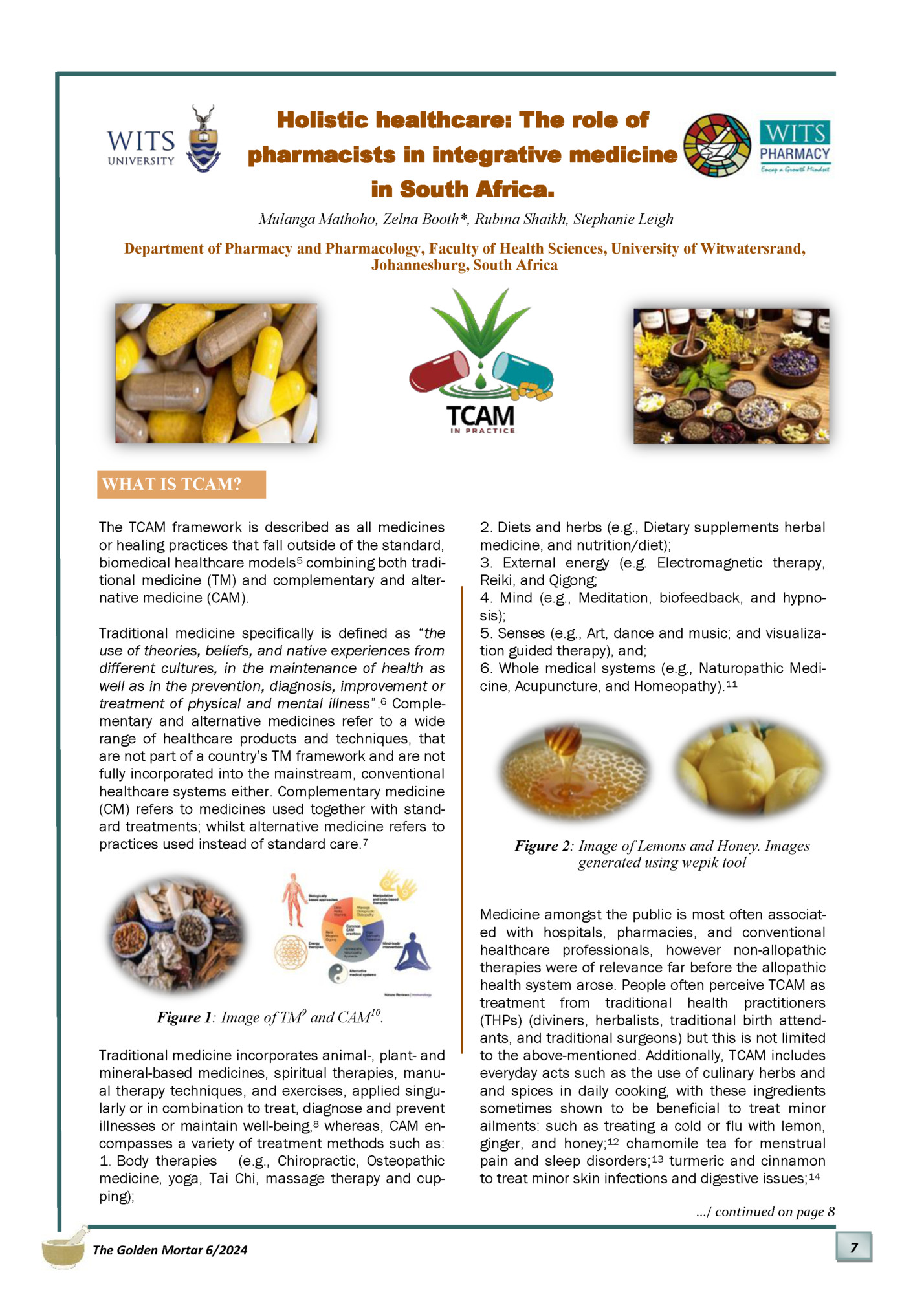
and receiving a massage or doing yoga to relieve stress or manage pain.15 Today, TCAMs are widely used and are becoming increasingly popular around the world.16 Figure 3: Image of Chamomile tea and Rosemary. Images generated using wepik tool In 2020, WHO declared COVID-19 a global pandemic. Many people turned to TCAM to allegedly treat or prevent COVID-19.17 In South Africa, there was an increase in the demand for a TM named Artemisia afra, commonly referred to as “umhlonyane” in IsiZulu. It was sold in the traditional markets available in Johannesburg and street sellers.22 Given that TCAM plays a role even in today’s healthcare frameworks, amongst people suffering from infectious and chronic diseases, suggests that TCAM can no longer be ignored in the modern healthcare sphere. Figure 4: Image of Muthi markets and umhlonyane. BENEFITS OF TCAM INTERGRATION • • • • Holistic treatment approach Patient-centred care Patient empowerment (healthcare autonomy) Personalized treatment CHALLENGES OF TCAM INTERGRATION • • • • Safety and efficacy with combination use Lack of regulatory frameworks for TCAM Lack of scientific evidence for TCAM Lack of training on TCAM ROLE OF PHARMACISTS IN TCAM INTERGRATION Pharmacists ensure the safe, effective, and rational use of medicine, which should be inclusive of TCAM. Pharmacists can play several roles in TCAM integration including: • Patient education and guidance • Quality assurance • • • • Safety integration with conventional medicine. Monitoring and follow-ups Research and Evidence-Based Practice Developing TCAM clinical decisionmaking tools. With the high prevalence of TCAM use in South Africa, pharmacists should be actively engaging with patients on TCAM use. Furthermore, pharmacists should educate themselves in TCAM and potential interactions with conventional medicines, to promote patient-centred care and holistic health outcomes in a country burdened with disease. We can improve patient access to safe and effective healing modalities in South Africa and worldwide by embracing our roles as pharmacists in integrating TCAM and expanding healthcare delivery. REFENCES 1. IDA Foundation (n.d.). Essential Medicines. Available at: https://www.idafoundation.org/en/ essential-medicines [Accessed 20 Jun. 2023]. Image of pills - conventional medicine. 2. Sharma, R. (2023). Lupin bags USFDA nod for Dolutegravir, Rilpivirine Tablets to treat HIV infection. [online] medicaldialogues.in. Available at: https://medicaldialogues.in/news/industry/ pharma/lupin-bags-usfda-nod-for-dolutegravirrilpivirine-tablets-to-treat-hiv-infection-105667 [Accessed 2 Jul. 2024]. 3. African View by Calyo. (2017). Herbs: African Medicine. [online] Available at: https:// africanviewbycalyo.com/viewBlog?s=herbs african-medicine [Accessed 2 Jul. 2024]. 4. www.africaresearchinstitute.org. (n.d.). https:// www.africaresearchinstitute.org/newsite/tag/ t r a d i t i o n a l / , h t t p s : / / www.africaresearchinstitute.org/newsite/tag/ traditional/. [online] Available at: https:// www.africaresearchinstitute.org/newsite/tag/ traditional/ [Accessed 2 Jul. 2024]. 5. Booth, Z., van Vuuren, S. F. (2023). The combined use of african natural products and conventional antimicrobials: an alternative tool against antimicrobial resistance. Antimicrobial Research and One Health in Africa, 317–346. Springer International Publishing. 317–346. https://doi.org/10.1007/978-3-031-237966_14 6. World Health Organization (WHO). (2019). WHO global report on traditional and complementary medicine 2019. Geneva: World Health Organisation. Available at: https://www.who.int/ publications/i/item/978924151536 (Accessed: 5 March 2022). 7. Keene, M. R., Heslop, I. M., Sabesan, S. S., & Glass, B. D. (2023). Knowledge, attitudes, and practices of Australian oncology health professionals on complementary medicines. …/ continued on page 9 The Golden Mortar 6/2024 8
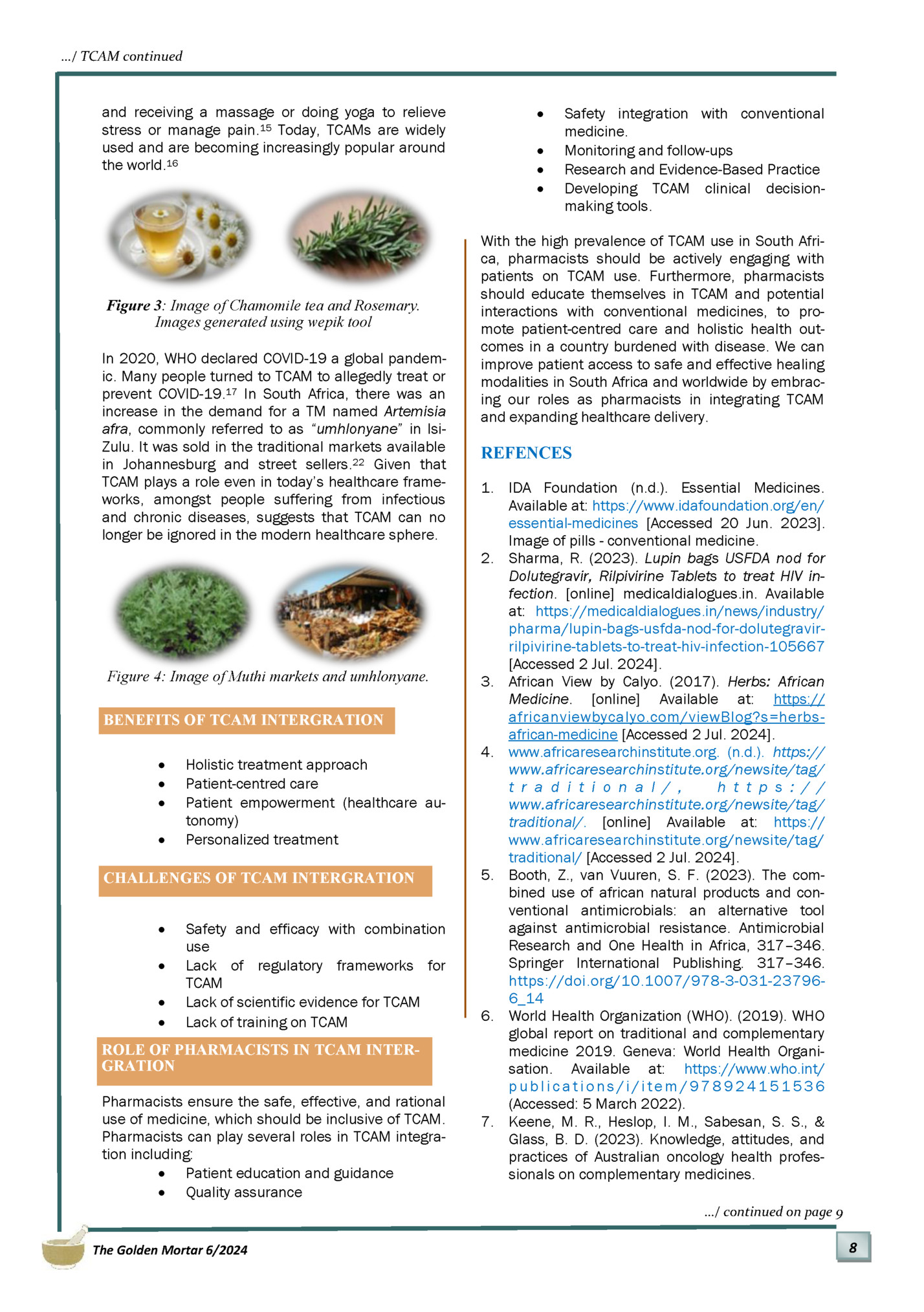
Journal of Pharmacy Practice and Research, 53(1), 10–17. https://doi.org/10.1002/jppr.1838 8. Tesfahuneygn, G. and Gebreegziabher, G. (2019). Medicinal Plants Used in Traditional Medicine by Ethiopians: A Review Article, Journal of Genetics and Genetic Engineering. Available at: https:// www.researchgate.net/publication/330243259 9. Khaas, P. (2023). African traditional medicine day recognises deep-rooted practices. [online] RHAP. Available at: https://rhap.org.za/2023/08/african-traditional-medicine-day-recognizes-deep-rooted-practices/ [Accessed 2 Jul. 2024]. 10. Goldrosen, M.H. and Straus, S.E. (2004). Complementary and alternative medicine: assessing the evidence for immunological benefits. Nature Reviews Immunology, [online] 4(11), 912–921. doi: https:// doi.org/10.1038/nri1486. 11. Johns Hopkins Medicine. (2019). Types of complementary and alternative medicine. Available at: https:// www.hopkinsmedicine.org/health/wellness-and-prevention/types-of-complementary-and-alternativemedicine (Accessed: 17 April 2022); National Cancer Institute. (2023). Complementary and Alternative Medicine. Available at: https://www.cancer.gov/about-cancer/treatment/cam (Accessed: 17 November 2023) 12. Chiru, T., Fursenco, C., Ciobanu, N., Dinu, M., Popescu, E., Ancuceanu, R., Volmer, D. and Raal, A., (2020). Use of medicinal plants in complementary treatment of the common cold and influenza – perception of pharmacy customers in Moldova and Romania, Journal of Herbal Medicine, 21(2020), 100-346. Available at: https://doi.org/10.1016/j.hermed.2020.100346. 13. Murtiningsih et al. (2022). The effectiveness of yoga and chamomile tea on sleep quality in adolescents experiencing dysmenorrhea, KnE Medicine, 2(2), 198–206. Available at: https://doi.org/10.18502/ kme.v2i2.11082 14. Fadhlizil, F.M.A.M., Moyeenul Huq, A.K.M. and Akil, H.M. (2022). Role of turmeric and cinnamon spices in digestive, metabolic, and immune systems, in Nutrition and 107 Functional Foods in Boosting Digestion, Metabolism and Immune Health. Elsevier, 209–217. Available at: https://doi.org/10.1016/B978-0-12821232-5.00027-6. 15. Miake-Lye, I.M., Mak, S., Lee, J., Luger, T., Taylor, S.L., Shanman, R., BeroesSeverin, J.M. and Shekelle, P.G., (2019). Massage for pain: An evidence map, The Journal of Alternative and Complementary Medicine, 25 (5), 475–502. Available at: https://doi.org/10.1089/acm.2018.0282. 16. James, P.B., Wardle, J., Steel, A. and Adams, J., 2018. Traditional, complementary, and alternative medicine use in Sub-Saharan Africa: a systematic review. BMJ Global Health, 3(5): 895. 17. Cucinotta, D., and Vanelli, M. (2020) ‘WHO Declares COVID-19 a Pandemic.’, Acta bio-medica: Atenei Parmensis, 91(1), 157–160. Available at: https://doi.org/10.23750/abm.v91i1.9397. 18. Wire, N. (2020). Covid-19-positive cases in Gauteng now stand at 813. [online] The Citizen. Available at: https://www.citizen.co.za/news/covid-19-positive-cases-in-gauteng-now-stand-at-813/ [Accessed 2 July 2023]. 19. www.facebook.com. (n.d.). Facebook. [online] Available at: https://www.facbook.com/photo.php? fbid=532722225547472&id=100064290985289&set=.454337560052606&locale=pt_PT [Accessed 2 July 2023]. 20. Langa, S. (2022). Ingabe abantu bayakholelwa emakhambini esintu ukuthiba iCOVID? [online] The Ulwazi Programme. Available at: https://www.ulwaziprogramme.org/ingabe-abantu-bayakholelwa-emakhambiniesintu-ukuthiba-icovid/ [Accessed 2 July 2023]. 21. Lulamile Feni, Mandla Khoza (2020). Roaring trade as villagers’ cash in on umhlonyane as Covid-19 ‘cure’. [online] SowetanLIVE. Available at: https://www.sowetanlive.co.za/news/south-africa/2020-05-14-roaringtrade-as-villagers-cash-in-on-umhlonyane-as-covid-19-cure/ [Accessed 2 July 2023]. 22. Wild, S. (2021), January 18). Miracles and medicine: how COVID-19 has been changing the traditional remedies game. Available at: https://bhekisisa.org/healthnews-south-africa/2021-01-18-miracles-andmedicine-how-covid-19-has-beenchanging-the-traditional-remedies-game/ (Accessed: 19 April 2023). R285 R165 R325 R95 The Golden Mortar 6/2024 R360 To start your very own collection please contact: Cecile @ 011 442 3615 ceciler@pssasg.co.za 9
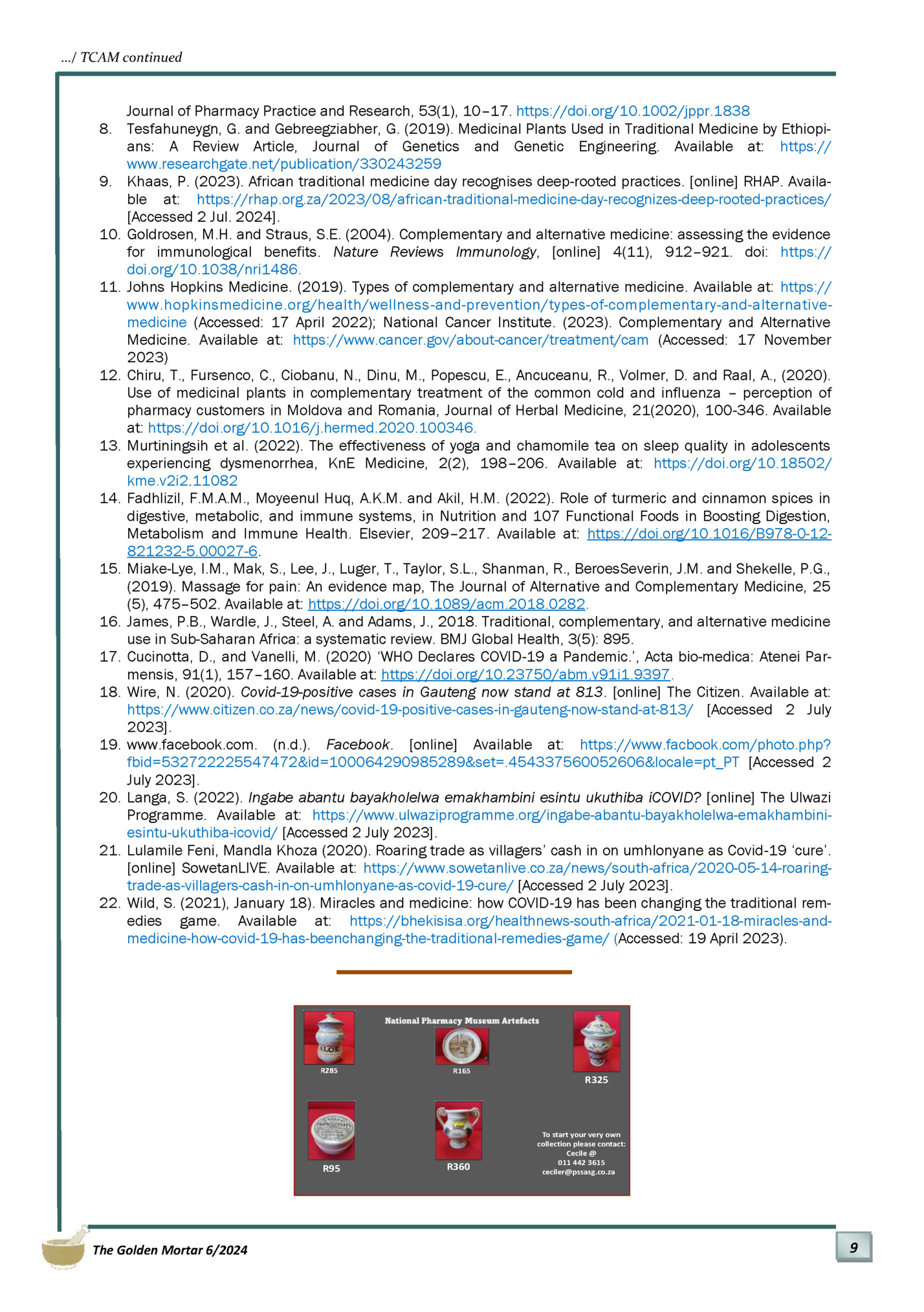
Fleepit Digital © 2021